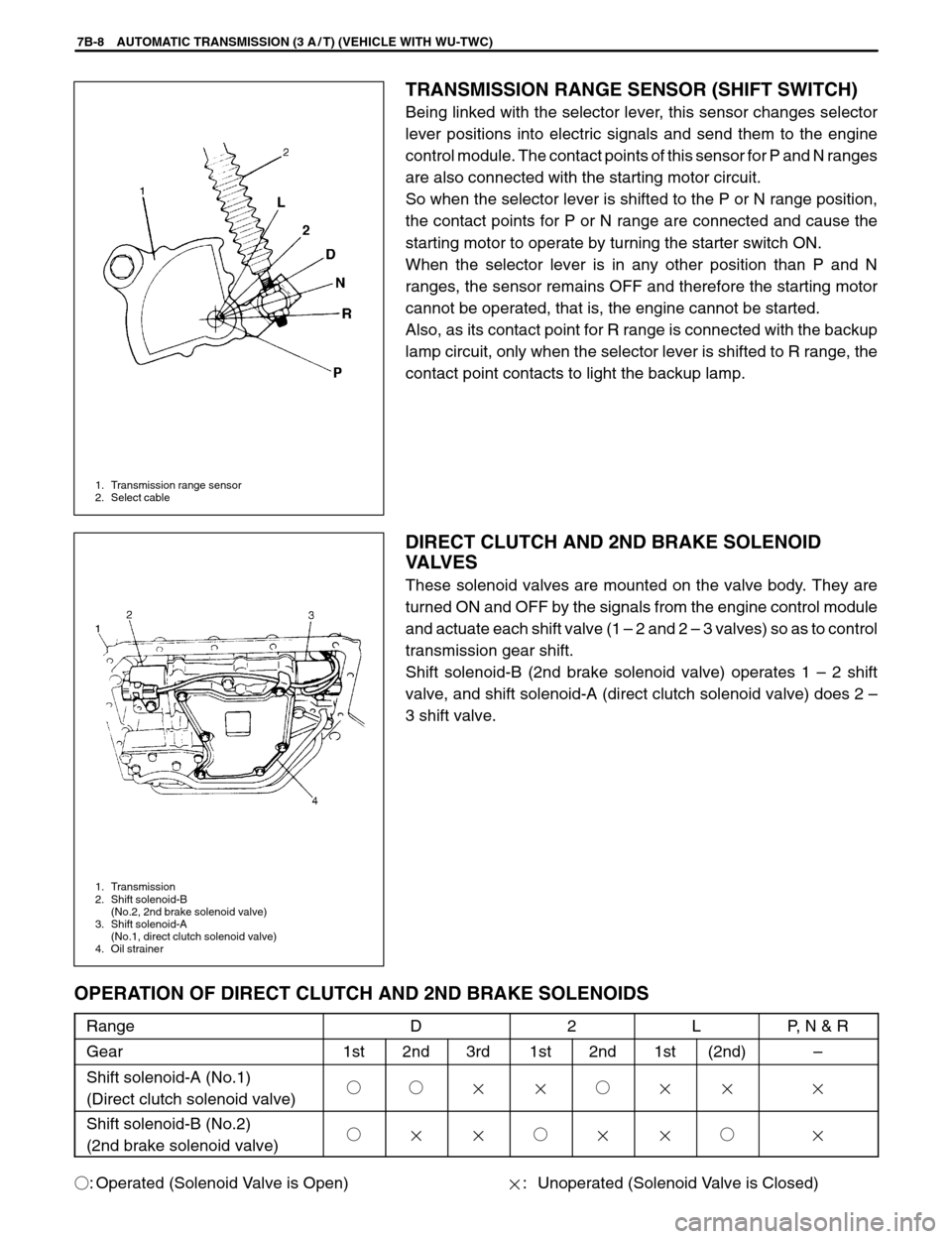Page 494 of 557

1. Final gear
2. Differential gear assembly
3. Counter shaft
4. 1st and reverse brake
5. Counter driven gear11. Forward clutch
12. Direct clutch
13. Input shaft
14. Torque converter
15. Oil pump 6. Output shaft
7. Rear planetary gear
8. Front planetary gear
9. Valve body assembly
10. Oil strainer
AUTOMATIC TRANSMISSION (3 A / T) (VEHICLE WITH WU-TWC) 7B-3
GENERAL DESCRIPTION
The automatic transmission consists of the hydraulic torque converter, electronically controlled 3-speed automatic
transmission, countershaft and differential.
The transmission consists of 2 planetary gears, 2 disk clutches, 1 band brake, 1 disk brake and 1 one-way clutch.
Its operation is controlled by selecting a position from 6 positions (P, R, N, D, 2 and L ranges) manually by means
of the selector lever installed on the compartment floor.
In the D or 2 range, the gear ratio is changed for the 1st, 2nd or 3rd speed (D range only) automatically by engine
control module (electronic control).
For the automatic transmission fluid, DEXRON
-��E, DEXRON-��� or its equivalent must be used. Lubrication
in the automatic transmission is provided by the oil pump which is operated by the engine revolution. Therefore,
the engine should not be stopped even during coasting to obtain proper lubrication.
When it becomes necessary to be towed, front wheels must be raised so as not to roll them.
Page 496 of 557
[G10 Engine Model]
1. PCM
2. Camshaft position (CMP) sensor
3. Throttle position (TP) sensor
4. Engine coolant temperature (ECT) sensor
5. Transmission range sensor (shift switch)
6. Output shaft speed sensor (A / T VSS)7. Malfunction indicator lamp (MIL)
8. Data link connector (DLC)
9. Shift solenoid-A
(No.1, Direct clutch solenoid valve)
10. Shift solenoid-B
(No.2, 2nd brake solenoid valve)11. Ignition switch
12. Main relay
13. Inhibitor switch
14. To starter
15. Terminal arrangement of PCM coupler
(Viewed from harness side)
AUTOMATIC TRANSMISSION (3 A / T) (VEHICLE WITH WU-TWC) 7B-5
ELECTRONIC SHIFT CONTROL SYSTEM
Page 497 of 557
7B-6 AUTOMATIC TRANSMISSION (3 A / T) (VEHICLE WITH WU-TWC)
[G13 Engine Model]
1. PCM
2. Camshaft position (CMP) sensor
3. Throttle position (TP) sensor
4. Engine coolant temperature (ECT) sensor
5. Transmission range sensor (shift switch)
6. Output shaft speed sensor (A / T VSS)7. Malfunction indicator lamp (MIL)
8. Data link connector (DLC)
9. Shift solenoid-A
(No.1, Direct clutch solenoid valve)
10. Shift solenoid-B
(No.2, 2nd brake solenoid valve)11. Ignition switch
12. Main relay
13. Inhibitor switch
14. To starter
15. Terminal arrangement of PCM coupler
(Viewed from harness side)
Page 498 of 557

1. PCM
2. Instrument panel
TP sensor
Transmission range sensor
Output shaft speed sensor
(A / T VSS)
Shift solenoid-B
(2nd brake solenoid valve)
Shift solenoid-A
(Direct clutch solenoid valve)PCM
1. Throttle position sensor
2. Throttle body
A: Ground
3. Ground terminal
4. Reference voltage
terminal
5. Output voltage terminal
6. TP sensor
C: Output voltage
(opening angle signal)
D: Power supply from ECM
(reference voltage)
[G10 engine model]
[G13 engine model]
AUTOMATIC TRANSMISSION (3 A / T) (VEHICLE WITH WU-TWC) 7B-7
POWERTRAIN CONTROL MODULE (PCM)
The powertrain control module controls the shift solenoid B (2nd
brake solenoid valve) and the shift solenoid A (direct clutch sole-
noid valve) by sending electric signals to them so as to attain auto-
matic gear shift between the 1st and 2nd gears, and the 2nd and
3rd gears. Equipped as PCM sensed parameters are the throttle
position sensor, transmission range switch and vehicle speed sen-
sor. These switch and sensors sense the throttle valve opening, se-
lector lever’s position and vehicle speed, and send those signals to
the powertrain control module. Then, the powertrain control module
opens and closes valves of the above solenoids according to these
signals. The powertrain control module is installed to the underside
of the instrument panel at the driver’s seat side.
GEAR SHIFT CONTROL SYSTEM
THROTTLE POSITION SENSOR (TP sensor)
The throttle position sensor consisting of a potentiometer is con-
nected to the throttle valve shaft.
Throttle valve opening signal (output voltage) is transmitted from
throttle position sensor to PCM as voltage signal. PCM uses it as
one of the signals to control transmission gear shift.
Page 499 of 557

1. Transmission range sensor
2. Select cable
1. Transmission
2. Shift solenoid-B
(No.2, 2nd brake solenoid valve)
3. Shift solenoid-A
(No.1, direct clutch solenoid valve)
4. Oil strainer
7B-8 AUTOMATIC TRANSMISSION (3 A / T) (VEHICLE WITH WU-TWC)
TRANSMISSION RANGE SENSOR (SHIFT SWITCH)
Being linked with the selector lever, this sensor changes selector
lever positions into electric signals and send them to the engine
control module. The contact points of this sensor for P and N ranges
are also connected with the starting motor circuit.
So when the selector lever is shifted to the P or N range position,
the contact points for P or N range are connected and cause the
starting motor to operate by turning the starter switch ON.
When the selector lever is in any other position than P and N
ranges, the sensor remains OFF and therefore the starting motor
cannot be operated, that is, the engine cannot be started.
Also, as its contact point for R range is connected with the backup
lamp circuit, only when the selector lever is shifted to R range, the
contact point contacts to light the backup lamp.
DIRECT CLUTCH AND 2ND BRAKE SOLENOID
VALVES
These solenoid valves are mounted on the valve body. They are
turned ON and OFF by the signals from the engine control module
and actuate each shift valve (1 – 2 and 2 – 3 valves) so as to control
transmission gear shift.
Shift solenoid-B (2nd brake solenoid valve) operates 1 – 2 shift
valve, and shift solenoid-A (direct clutch solenoid valve) does 2 –
3 shift valve.
OPERATION OF DIRECT CLUTCH AND 2ND BRAKE SOLENOIDS
RangeD2LP, N & R
Gear1st2nd3rd1st2nd1st(2nd)–
Shift solenoid-A (No.1)
(Direct clutch solenoid valve)��������
Shift solenoid-B (No.2)
(2nd brake solenoid valve)��������
�: Operated (Solenoid Valve is Open)�: Unoperated (Solenoid Valve is Closed)
Page 500 of 557

1. Countershaft gear
2. Output shaft speed sensor
A: Magnetic core end
D or 2
1→2
18
11
52
33D
2→3
33
21
97
613→2
14
9
82
51D or 2
2→1
14
9
37
23L
2→1
37
23
37
23 Full close
Full openkm / h
mile/h
km / h
mile/h Throttle SpeedGear Selector
VEHICLE SPEED
UpshiftDownshift
THROTTLE VALVE OPENING
[G10 Engine Model]
AUTOMATIC TRANSMISSION (3 A / T) (VEHICLE WITH WU-TWC) 7B-9
OUTPUT SHAFT SPEED SENSOR (A / T VSS)
The output shaft speed sensor consists of a magnetic core with
magnet and coil. It is mounted on transmission case with 0.6 mm
(0.024 in.) air gap between the core end and countershaft gear
tooth.
While the countershaft rotates, magnetic flux is cut by gear tooth
thus a pulse is generated in the sensor coil according to the speed.
And then, the pulse is transmitted to engine control module as
speed signal.
AUTOMATIC SHIFT DIAGRAM
Automatic shift schedule as a result of shift control is shown below. In case that selector lever is shifted to L range
at a higher than 37 km / h (23 mile / h) (G10 engine model), 40 km / h (25 mile / h) (G13 engine model) speed, 2nd
gear is operated and then down shifts to 1st at a speed lower than that. No up shift is available in L range.
Page 501 of 557
7B-10 AUTOMATIC TRANSMISSION (3 A / T) (VEHICLE WITH WU-TWC)
D or 2
1→2
18
11
58
36D
2→3
30
19
11 0
693→2
14
9
97
61D or 2
2→1
14
9
40
25L
2→1
40
25
40
25 Full close
Full openkm / h
mile/h
km / h
mile/h Throttle SpeedGear Selector
VEHICLE SPEED
Upshift
Downshift
THROTTLE VALVE OPENING
[G13 Engine Model]
Page 519 of 557

ACCEPTABLE RANGE
1st gear (solenoids ON and ON)
2nd gear
(solenoids ON and OFF)
3rd gear
(solenoids OFF and OFF)
Vehicle speed
Engine speed
7B-28 AUTOMATIC TRANSMISSION (3 A / T) (VEHICLE WITH WU-TWC)
DTC P0751 SHIFT SOLENOID-A (No.1) PERFORMANCE OR STUCK OFF
DTC P0756 SHIFT SOLENOID-B (No.2) PERFORMANCE OR STUCK OFF
CIRCUIT DESCRIPTION
PCM monitors throttle opening, engine speed, vehicle speed and gear position and compares the actual engine
speed and its specified value (i.e., engine speed obtained by PCM through calculation using the throttle open-
ing / gear position and vehicle speed).
DTC DETECTING CONDITION
POSSIBLE CAUSE
�While running in “D” range after engine warmed up,
engine speed as compared with vehicle speed is not
within acceptable range.
�2 driving cycle detection logic, continuous
monitoring.�A / T oil pressure control cable maladjusted
�Selector cable maladjusted
�Mechanical malfunction of shift solenoid valve
(stick or leakage)
�Mechanical malfunction in transmission
�Torque converter malfunction
DTC CONFIRMATION PROCEDURE
WARNING:
�When performing a road test, select a place where there is no traffic or possibility of a traffic accident
and be very careful during testing to avoid occurrence of an accident.
�Road test should be carried out with 2 persons, a driver and a tester, on a level road.
1) Turn ignition switch OFF.
2) Clear DTC with ignition switch ON and warm up engine to normal operating temperature.
3) Shift selector lever to “D” range.
4) Start vehicle and increase vehicle speed to 40 – 55 km / h ( 25 – 35 mile / h) by depressing accelerator pedal half
a stroke.
5) Keep vehicle at above speed for 5 sec. or longer.
6) Increase vehicle speed to 75 – 90 km / h (45 – 55 mile / h) by depressing accelerator pedal half a stroke and keep
it at that speed for 5 sec. or longer.
7) Stop vehicle and check pending DTC and DTC.